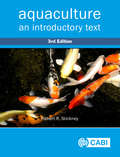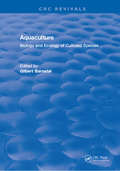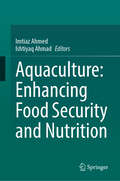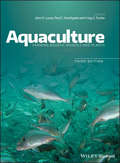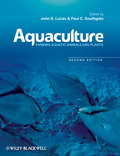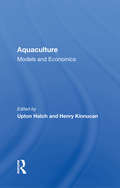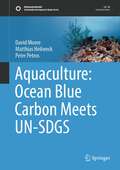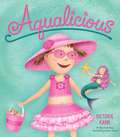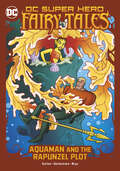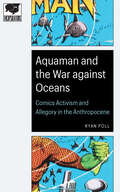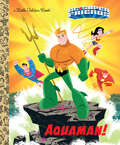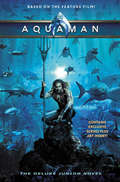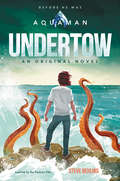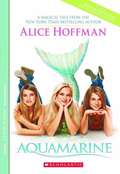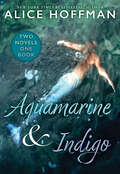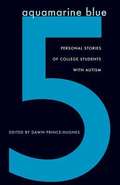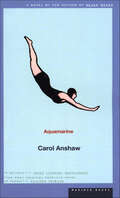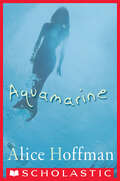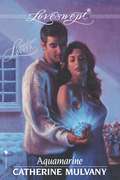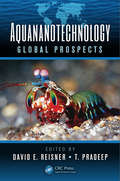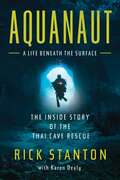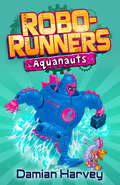- Table View
- List View
Aquaculture: An Introductory Text
by Robert R StickneyProviding a broad and readable overview of the subject, this updated third edition of Aquaculture: An Introductory Text covers issues associated with sustainable aquaculture development, culture systems, hatchery methods, nutrition and feeding of aquaculture species, reproductive strategies, harvesting and many other topics. While its main focus is on the culture of fish, molluscs and crustaceans for food, the book also covers other forms of aquaculture, such as the production of seaweeds, recreational fish and ornamental species, and live foods such as algae and rotifers that are used to feed larval shrimp and marine fish. Thoroughly updated and revised, the third edition of this essential textbook now includes: - Increased coverage of species under culture - Increased scope to cover species for enhancement, recreational fishing, commercial fishing and aquaria - Newly developed culture systems - Information on predictive impacts of climate change - Updated aquaculture production statistics Aquaculture remains one of the most rapidly growing agricultural disciplines and this book remains an essential resource for all students of aquaculture and related disciplines.
Aquaculture: Biology and Ecology of Cultured Species
by Gilbert BarnabeThis unique book introduces the biological and ecological basis of the production process in water, and the biology of cultured species. It bridges the gap between research data and aquaculture techniques, and covers problems arising in aquaculture production, such as filtering molluscs. It also introduced modern aspects of oceanography that are important for understanding the production process. The book starts with a section dedicated to the production of living material and matter in the aquatic environment. It then goes on to explore in detail the biological basis of mollusc, crustacean and fish cultures, and the reproduction and nutrition of bivalve molluscs. Also discussed are the intensive and extensive aquaculture producing processes in fresh and marine waters, and finally the pathology reared animals. Up-to-date data are provided and explained to the student using graphs and copious illustrations. The work is especially orientated toward the student reader and provides a comprehensive and authoritative text on the subject.
Aquaculture: Enhancing Food Security and Nutrition
by Imtiaz Ahmed Ishtiyaq AhmadThis work compiles the impact of aquaculture in addressing the pressing challenges of global food security and nutritional deficits. The book provides a comprehensive understanding about how aquaculture is playing an instrumental role in ensuring a sustainable and nourished food source. In the face of a growing global population and increasing demands for protein-rich diets, traditional means of fish and its products from wild fisheries alone are inadequate which warrant an alternate source that can fulfill the demand of fish for human consumption. Aquaculture emerges as a sustainable solution, promising to bridge the widening gap between the supply and demand for fish and its products. Through meticulously researched insights and data, the book showcases how aquaculture systems are meeting the protein and nutritional needs of people worldwide. The book entitled as &“Aquaculture: Enhancing Food Security and Nutrition&” sheds light on the various forms of aquaculture like freshwater, marine and brackish water cultivation highlighting their benefits and potential drawbacks. The focus is on in what way aquaculture practices can be environmentally responsible, economically viable and socially inclusive, paving the itinerary for a balanced and sustainable food ecosystem. By exploring the advancements in aquaculture technologies such as recirculating aquaculture systems (RAS) and integrated multi-trophic aquaculture (IMTA), the book also advocates the environmental friendly and resource-efficient practices that enhance both food security and nutrition. Moreover, the book underscores the nutritional value of fish and its products, highlighting their rich nutrient composition including protein, amino acids, fatty acids, vitamins and minerals, which are fundamental for human health. It also offers insights about the incorporation of fish and its products in the food that can positively impact nutrition and combat malnutrition, especially in vulnerable human populations.
Aquaculture: Farming Aquatic Animals and Plants
by John S. Lucas Paul C. Southgate Craig S. TuckerA clear illustration of the important role of aquaculture in supporting food security, livelihoods, and economic development around the world This new edition of Aquaculture: Farming Aquatic Animals and Plants covers important aspects of the culture of fish, shellfish, and algae in freshwater and marine environments. Subject areas covered include principles of aquaculture, water quality, environmental impacts of aquaculture, desert aquaculture, reproduction, life cycles and growth, genetics and stock improvement, nutrition and feed production, diseases, vaccination, post-harvest technology, economics and marketing, and future developments of aquaculture. Separate chapters also cover the culture of algae, carps, salmonids, tilapias, catfish, marine and brackish fishes, soft-shelled turtles, barramundi, marine shrimp, mitten crabs, and other decapod crustaceans, bivalves, gastropods, and ornamental species. This edition also provides greater coverage of aquaculture in China, reflecting the country’s importance in the global scene. Providing core scientific and commercially useful information, and written by 35 eminent international authors, this expanded and fully updated Third Edition of Aquaculture is essential reading for all students and professionals studying and working in aquaculture. Fish farmers, hatchery managers, and those in aquaculture support and supply industries, such as feed manufacturing, will find an abundance of commercially useful information within this important and now established book. Describes the multitude of developments that have occurred within the aquaculture field over the last 15 years Includes a major revision of production statistics and trends, discussion of technical developments, and revised and extended coverage provided by broader international authorship Brings together 35 internationally recognized contributors, including a number of new contributors Aquaculture: Farming Aquatic Animals and Plants, Third Edition is a recommended text for students of the subject and a concise reference for those working in or entering into the industry.
Aquaculture: Farming Aquatic Animals and Plants
by John S. Lucas Paul C. SouthgateThe output from world aquaculture, a multi-billion dollar global industry, continues to rise at a very rapid rate and it is now acknowledged that it will take over from fisheries to become the main source of animal and plant products from aquatic environments in the future. Since the first edition of this excellent and successful book was published, the aquaculture industry has continued to expand at a massive rate globally and has seen huge advances across its many and diverse facets. This new edition of Aquaculture: Farming Aquatic Animals and Plants covers all major aspects of the culture of fish, shellfish and algae in freshwater and marine environments. Subject areas covered include principles, water quality, environmental impacts of aquaculture, desert aquaculture, reproduction, life cycles and growth, genetics and stock improvement, nutrition and feed production, diseases, vaccination, post-harvest technology, economics and marketing, and future developments of aquaculture. Separate chapters also cover the culture of algae, carps, salmonids, tilapias, channel catfish, marine and brackish fishes, soft-shelled turtles, marine shrimp, mitten crabs and other decapod crustaceans, bivalves, gastropods, and ornamentals. There is greater coverage of aquaculture in China in this new edition, reflecting China's importance in the world scene. For many, Aquaculture: Farming Aquatic Animals and Plants is now the book of choice, as a recommended text for students and as a concise reference for those working or entering into the industry. Providing core scientific and commercially useful information, and written by around 30 internationally-known and respected authors, this expanded and fully updated new edition of Aquaculture is a book that is essential reading for all students and professionals studying and working in aquaculture. Fish farmers, hatchery managers and all those supplying the aquaculture industry, including personnel within equipment and feed manufacturing companies, will find a great deal of commercially useful information within this important and now established book. Reviews of the First Edition "This exciting, new and comprehensive book covers all major aspects of the aquaculture of fish, shellfish and algae in freshwater and marine environments including nutrition and feed production." —International Aquafeed "Do we really need yet another book about aquaculture? As far as this 502-page work goes, the answer is a resounding 'yes'. This book will definitely find a place in university libraries, in the offices of policy-makers and with economists looking for production and marketing figures. Fish farmers can benefit greatly from the thematic chapters, as well as from those pertaining to the specific plant or animal they are keeping or intending to farm. Also, they may explore new species, using the wealth of information supplied." —African Journal of Aquatic Science "Anyone studying the subject or working in any way interested in aquaculture would be well advised to acquire and study this wide-ranging book. One of the real 'bibles' on the aquaculture industry." —Fishing Boat World and also Ausmarine
Aquaculture: Models And Economics
by Upton HatchPresenting state-of-the-art research on the economics of producing and marketing aquacultural products, this volume addresses critical issues concerning profitability, market acceptance, and economic modeling of various aquacultural products. Research approaches range from firm-level bioeconomic modelling to market-level econometric modelling of industry growth and product substitution. The studies highlight the institutional structures and public policy issues that will shape growth and development of aquaculture into the twenty-first century, including trade policies, food safety, and environmental quality.
Aquaculture: Ocean Blue Carbon Meets UN-SDGS (Sustainable Development Goals Series)
by David Moore Peter Petros Matthias HeilweckThis book presents a solutions based approach to reducing and removing CO2 from the atmosphere transforming it into solid (crystalline) CaCO3 through the ability of marine organisms such as molluscs, crustacea, corals, and coccolithophore algae. The overwhelming advantage of this approach is that it promises enhanced climate mitigation in comparison to planting forests, industrial/engineering carbon capture and storage process. It also provides a sustainable food resource. Furthermore, it would improve the ocean's biodiversity at the same time as the excess atmospheric CO2 released by our use of fossil fuels is returned to the place it belongs - as a present day fossil, safely out of the atmosphere to the distant future. If the level of finance and global effort that are readily foreseen for forest management and flue gas treatments were applied to expansion of global shellfish cultivation, curative amounts of carbon dioxide could be permanently removed from the atmosphere within a few decades. The concept presented in this book could have a profound influence on the life of the planet.
Aquafaba: Sweet and Savory Egg-Free Vegan Recipes Using the Magic of Bean Water
by Zsu DeverThe bean liquid we used to throw away turns out to be one of the most astonishing culinary discoveries of the decade. With its amazing egg-replacement abilities, miraculous "aquafaba" can be used as an egg-replacer to make everything from French toast to lemon meringue pie. Aquafaba can be used as a binder in both sweet and savory recipes and is a boon to vegans, people with egg allergies, as well as anyone interested in innovative cooking with a magical new ingredient.Aquafaba includes the story of how the bean liquid properties were discovered, how to use it, and how to make fabulous recipes, including:wafflescrepesquicheburgersmacaronsmarshmallowsAquafaba can even be used to make dairy-free cheese, ice cream, butter, and so much more. The book also includes a chapter filled with recipes that use the chickpeas and beans that remain after using their liquid to make aquafaba.The latest title by San-Diego-based author Zsu Dever (author of Vegan Bowls and Everday Vegan Eats), Aquafaba features Zsu's signature photography, her easy-to-follow instructions, and metric conversion charts.
Aqualicious
by Victoria KannFun in the sun becomes an aqualicious adventure when Pinkalicious meets a miniature mermaid in #1 New York Times bestselling author Victoria Kann's popular hardcover picture book starring Pinkalicious. Pinkalicious and her family go on a trip to the beach for a day of sun, fun, and sand castles! The day gets even more exciting when Pinkalicious finds a mini-mermaid named Aqua while she's collecting shells. Aqua wants to find her way home, and Pinkalicious and Peter decide to help--after they show her all of the pinkamazing things to do at the seashore! Pinkalicious stars in five picture books--Pinkalicious, Goldilicious, Silverlicious, Emeraldalicious, and Aqualicious--as well as I Can Reads, doodle books, and more!
Aqualisa Quartz: Simply a Better Shower
by Youngme Moon Kerry HermanHarry Rawlinson is managing director of Aqualisa, a major U.K. manufacturer of showers. He has just launched the most significant shower innovation in recent history: the Quartz shower. The shower provides significant improvements in terms of quality, cost, and ease of installation. In product testing, the Quartz shower received rave reviews from both consumers and plumbers alike. However, early sales of the Quartz have been disappointing. Rawlinson is now faced with some key decisions about whether to change his channel strategy, promotional strategy, and the overall positioning of the product in the context of his existing product line.
Aqualisa Quartz: Simply a Better Shower
by Youngme Moon Kerry HermanHarry Rawlinson is managing director of Aqualisa, a major U.K. manufacturer of showers. He has just launched the most significant shower innovation in recent history: the Quartz shower. The shower provides significant improvements in terms of quality, cost, and ease of installation. In product testing, the Quartz shower received rave reviews from both consumers and plumbers alike. However, early sales of the Quartz have been disappointing. Rawlinson is now faced with some key decisions about whether to change his channel strategy, promotional strategy, and the overall positioning of the product in the context of his existing product line.
Aquaman and the Rapunzel Plot (DC Super Hero Fairy Tales)
by Laurie S. SuttonAquaman’s underwater kingdom is facing a medical threat. Luckily, a sea witch offers him a rare plant to fight the sickness . . . in exchange for a hefty price. But the Sea King soon discovers she isn’t just greedy. The old woman has locked the true crop owner in an enchanted coral tower! What’s worse, the trapped mermaid thinks she’s being protected not imprisoned, so her living seaweed hair is ready to fight off any stranger who climbs inside. Can the Atlantean hero partner with the coral captive to end the witch’s fishy scheme? In this twisted retelling, DC Super Heroes and Super-Villains collide with the Rapunzel fairy tale to create an action-packed chapter book for kids!
Aquaman and the War against Oceans: Comics Activism and Allegory in the Anthropocene (Encapsulations: Critical Comics Studies)
by Ryan PollThe reimagining of Aquaman in The New 52 transformed the character from a joke to an important figure of ecological justice. In Aquaman and the War against Oceans, Ryan Poll argues that in this twenty-first-century iteration, Aquaman becomes an accessible figure for charting environmental violences endemic to global capitalism and for developing a progressive and popular ecological imagination. Poll contends that The New 52 Aquaman should be read as an allegory that responds to the crises of the Anthropocene, in which the oceans have become sites of warfare and mass death. The Aquaman series, which works to bridge the terrestrial and watery worlds, can be understood as a form of comics activism by its visualizing and verbalizing how the oceans are beyond the projects of the &“human&” and &“humanism&” and, simultaneously, are all-too-human geographies that are inextricable from the violent structures of capitalism, white supremacy, and patriarchy. The New 52 Aquaman, Poll demonstrates, proves an important form of ocean literacy in particular and ecological literacy more generally.
Aquaman! (Little Golden Book)
by Frank BerriosAn exciting Little Golden Book featuring Aquaman(TM) and the DC Super Friends(TM)!Aquaman(TM) is the King of the Seven Seas! Boys and girls ages 2 to 5 will learn how Aquaman(TM) uses his amazing abilities to help the DC Super Friends(TM) protect our world! This Little Golden Book is the perfect way to introduce young readers to the underwater adventurer better known as Aquaman(TM)! DC Super Friends(TM) is a unique brand that gives preschoolers their very own versions of the world's greatest superheroes from DC Comics: Superman(TM), Batman(TM), Wonder Woman(TM), Aquaman(TM), The Flash(TM), Cyborg(TM), Hawkman(TM), and Green Lantern(TM).
Aquaman: The Junior Novel (Aquaman)
by Jim McCannAQUAMAN hits the big screen on December 21, 2018. The all-star cast includes Jason Momoa, Amber Heard, Patrick Wilson, Nicole Kidman, Willem Dafoe, and more. Based on the major motion picture, Aquaman: The Junior Novel retells the action-packed story of Aquaman. This book contains never-before-seen scenes and a full-color section of eye-catching art.Home is calling. . . . Known to most as simply Aquaman, Arthur Curry possesses incredible powers. He’s also the reluctant heir to a mysterious underwater kingdom. But Arthur wants nothing to do with the people of Atlantis, who took his mother from him many years ago.Arthur’s destiny beckons when a vicious storm sends the warships of several world powers to shipwreck on the shores. This act is a warning from the King of Atlantis himself to the surface world: War is coming.Aquaman will have to travel deep beneath the sea to protect the surface world from the looming threat. In order to save the only world he’s ever known, will Aquaman embrace his destiny to unite the seven kingdoms of Atlantis?
Aquaman: Undertow (Aquaman)
by Steve Behling Dan BurgessAQUAMAN hits the big screen on December 21, 2018. The all-star cast includes Jason Momoa, Amber Heard, Patrick Wilson, Nicole Kidman, Willem Dafoe, and more. Aquaman: Undertow is the never-before-seen prequel story of a young Arthur Curry, set in the cinematic world of Aquaman and the DC Universe—perfect for fans of the highly anticipated movie! Before he was King of Atlantis . . . Thirteen-year-old Arthur Curry has enough troubles to sink a ship. His mom left him and his dad when Arthur was only three years old. He doesn't fit in with the other students at school. To them, he's just “fish boy,” a weird, freaky kid. But Arthur has a secret. Something so secret, even he doesn't know what it is. With the help of his only friend, Claudia, Arthur will begin to learn the truth about his mother, himself, and a legendary world that may actually exist.Oh, and he learns about octopuses. Octopi. It's probably octopi, right?
Aquamarine
by Alice HoffmanHailey and Claire discover a mermaid at the bottom of a murky pool, and a rescue is begun!
Aquamarine & Indigo (Two Novels, One Book)
by Alice HoffmanTwo luminous stories of friendship, magic, and the sea -- bound together in one beautiful volume -- by bestselling author Alice Hoffman.In Aquamarine, twelve-year-old best friends Hailey and Claire are enjoying their last summer together when they discover something at the bottom of the murky pool at the Capri Beach Club. There, among the seaweed and jellyfish that a summer storm washed in from the ocean, is a mysterious and beautiful creature with a sharp tongue and a broken heart -- a mermaid named Aquamarine.As her six sisters beckon to her to return to the sea, and Aquamarine begins to fade away in the burning August sun, she stubbornly refuses to leave the pool and persists in her search for love on dry land.On the edge of growing up, during a summer that is the hottest on record, Hailey and Claire learn that life can take an unpredictable course, that friendship is forever, and that magic can be found in the most unexpected places.In Indigo, thirteen-year-old Martha Glimmer is convinced this is the worst time of her life. Her mother died, she grew seven inches, and she has to put up with a woman who plies Martha's lonely father with food and opinions about how thirteen-year-old girls should behave. Martha longs to leave Oak Grove and travel. Her best friend Trevor and his brother Eli also want to leave Oak Grove. Nicknamed Trout and Eel because of the thin webbing between their fingers and toes, they long to see the ocean. When the trio decide to run away to the ocean, trouble ensues.Bestselling author Alice Hoffman weaves together two enchanting tales of friendship and magic, finding home and the sea.
Aquamarine Blue 5: Personal Stories of College Students With Autism
by Dawn Prince-HughesThe first book to be written by autistic college students who have been diagnosed with Asperger's Syndrome, or High Functioning Autism, Aquamarine Blue 5 demonstrates their unique way of looking at and solving problems and the challenges they face. These readable essays detail the struggles of a highly sensitive group and show that there are gifts specific to autistic students that enrich the university system, scholarship, and the world as a whole. Containing the stories of a dozen autistic students, the book deals with everything from learning to eat in dormitory dining halls to making friends to exploring sexuality.
Aquamarine: A Novel
by Carol AnshawOlympic swimmer Jesse Austin is seduced and consequently edged out for a gold medal by her Australian rival. From there, Anshaw intricately traces three possible paths for Jesse, spinning exhilarating variations on the themes of lost love and parallel lives unlived. Dorothy Allison, author of Bastard Out of Carolina, writes, "I found myself wishing I could buy a dozen copies and start a discussion group, just so I'd be able to debate all the questions this astonishing novel provokes." A Reader's Guide is available.
Aquamarine: Aquamarine And Indigo
by Alice HoffmanA New York Times bestseller—now a major motion picture. A luminous tale of nostalgia and enchantment, for readers both young and old.Hailey and Claire are spending their last summer together when they discover something at the bottom of the murky pool at the Capri Beach Club. There in the depths is a mysterious and beautiful creature with a sharp tongue and a broken heart: a mermaid named Aquamarine who has left her six sisters to search for love on land. Now, as this mythological yet very real being starts to fade in the burning August sun, a rescue is begun. On the edge of growing up, during a summer that is the hottest on record, Hailey and Claire are discovering that life can take an unpredictable course, friendship is forever, and magic can be found in the most unexpected places.“This spare, haunting novella . . . is a lovely introduction to the author’s storytelling genius and matter-of-fact lyrical style.” —The New York Times Book Review“Hoffman creates an apt metaphor for that twilight time between childhood and adolescence when magic still seems possible and friendships run deep and true.” —Publishers Weekly“In this small, spacious book, Hoffman’s spare words reveal the magic and the gritty realism in daily life, ‘somewhere between laughter and a wave breaking.’” —Booklist“This book has some wonderful elements—there is some vivid imagery, especially when it comes to the setting, with its waves of heat and air of decay.” —School Library Journal
Aquamarine: Loveswept
by Catherine MulvanyCould a strange glowing crystal hold the secrets of a generation? Was she a ghost sent to drive him mad? Teague Harris wondered when the woman he knew as Kirsten appeared without warning. Shea McKenzie insisted she knew nothing of his vanished fiancée, yet she couldn't explain why she'd been drawn to this town—nor deny Teague's anguished plea for her help. But when she began remembering things she couldn't know, Shea feared what her masquerade had unleashed. Was Teague her destiny . . . or her destroyer? Darkly sensual and deeply emotional, Catherine Mulvany's tale of passion, mystery, and murder teaches us that love can be stronger than death—and desire more powerful still. Bound by a longing she barely understood, she'd agreed to a perilous charade that could cost her everything, but did she dare risk her heart on a man with so many secrets? From the Paperback edition.
Aquananotechnology: Global Prospects
by T. Pradeep David E. ReisnerThe world's fresh water supplies are dwindling rapidly-even wastewater is now considered an asset. By 2025, most of the world's population will be facing serious water stresses and shortages. Aquananotechnology: Global Prospects breaks new ground with its informative and innovative introduction of the application of nanotechnology to the remediatio
Aquanaut: The Inside Story of the Thai Cave Rescue
by Rick StantonThe enthralling inside story of the Tham Luang cave rescue in Thailand—told by the leader of the daring underwater rescue mission.In July 2018, twelve boys and their soccer coach disappeared into the Tham Luang Cave in Thailand. Trapped miles beneath the surface, not even the Thai Navy SEALs had the skills to bring them to safety. With the floodwater rising rapidly, time was running out. Any hope of survival rested on Rick Stanton, a retired British firefighter with a living room full of homemade cave-diving equipment. As unlikely as it seemed, Rick and his partner, John Volanthen, were regarded as the A-team for exactly this kind of mission. The Thai Cave Rescue was the culmination of a lifelong obsession, requiring every ounce of skill and ingenuity accumulated by Rick over a four decade pursuit of the unknown. While the world held its breath, Rick, John, and their assembled team raced against time in the face of near impossible odds. There was simply no precedent for what they were attempting to do. . . .
Aquanauts: Book 6 (Robo-Runners #6)
by Damian HarveyMeet Crank and Al ... robots on the run.They arrive at the ancient city of Tarka, a flooded city behind a great wall. Hoping to discover Robotika, where robots can be free, instead they end up trapped between the mysterious underwater Aquanauts and the cruel Crodilus ...A refreshed cover look for this well-loved series, illustrated by the incomparable Mark Oliver. Read on with The Tin Man, Tunnel Racers, Razorbites, Powerball and The Ghost Sea.
